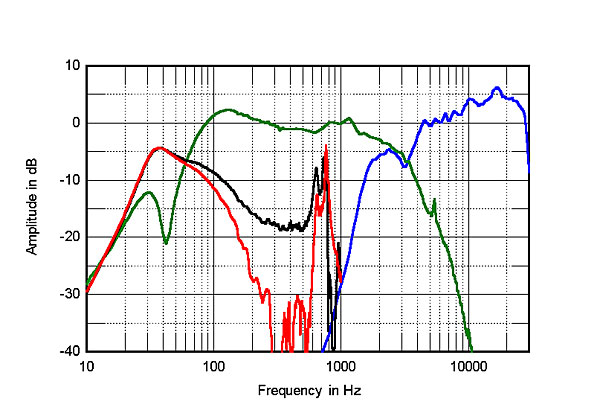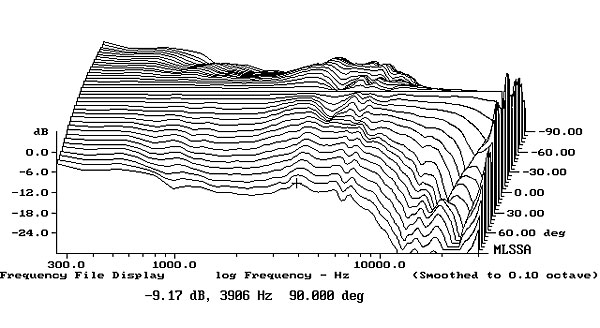| Columns Retired Columns & Blogs |
Is there anyway to fix the lively cabinet issue? Fiberglass stuffing? Add some cross bracing?
I subjected the RTi A3 to my usual test regime. I used DRA Labs' MLSSA system and a calibrated DPA 4006 microphone to measure the speaker's frequency response in the farfield, and an Earthworks QTC-40 for the nearfield responses. I estimated the Polk's voltage sensitivity at 89.3dB(B)/2.83V/m, which is both high and a little higher than the specified 89dB. This speaker will play loudly with relatively low-powered amplifiers. Fig.1 shows the RTi A3's electrical impedance and phase, plotted against frequency. The impedance drops just below 4 ohms in the lower midrange, and there is a combination of 5 ohms and a –35° phase angle at 120Hz; an amplifier or receiver rated into 4 ohms should work well with the Polk.
Stephen commented on the RTi A3's lively enclosure, and there is a small wrinkle between 200 and 300Hz in the impedance traces that implies the existence of cabinet resonances of some kind. Investigating the panels' vibrational behavior with a plastic-tape accelerometer uncovered a major resonance at 254Hz (fig.2), with lower-level modes visible at 285, 420, 650, 1170, and 1425Hz. The RTi A3's enclosure is larger than the RTi A1's, which allows for a more extended bass performance, but the larger panels will resonate at a lower frequency—which, in theory, should make the panel resonances more audible. However, SM noted no midrange congestion or coloration that might have been the result of so lively an enclosure.
The saddle in the impedance-magnitude trace in fig.1 indicates that the twin ports are tuned to 42Hz, the lowest note of the four-string electric bass guitar, rather than the 50Hz of the smaller RTi A1 (see my measurements of the RTi A1). The red and black traces in fig.3 confirm that the ports' outputs peak between 30 and 70Hz. But, as in the 'A1, the 'A3's ports are afflicted with powerful resonances in the upper midrange. These could be heard as adding a slight whistle to the sound of pink noise, but again it is fair to note that SM didn't comment on any coloration with music. (Polk points out that the port outputs are in opposite phase to one another so should cancel.) The green trace in fig.3 shows that the woofer crosses over to the tweeter (blue trace) between 2 and 4kHz with steep low- and high-pass filter slopes.



Fig.4 shows how these individual drive-unit outputs sum in the farfield. The response rise in the upper bass is almost entirely due to the nearfield measurement technique; the RTi A3 offers useful bass output to below 40Hz, which is excellent performance for a relatively small speaker.

The speaker's balance is commendably even from the lower midrange to the high treble, with the top octave somewhat exaggerated in level. As is usual with a 1" dome tweeter, the Polk's output falls off quite rapidly to the speaker's sides above 10kHz (fig.5); in a room of typical size this will compensate for the rise in on-axis response and result in a neutrally balanced high treble. But in a smaller room such as Stephen's, the on-axis peak in the top octave, perhaps coupled with the slight flare off axis at the base of the tweeter's passband also visible in fig.5, would contribute to his perception of the Polk's "vibrant highs" and "fast transients." In the vertical plane, the RTi A3's dispersion (fig.6) indicates that the speaker needs to be used with stands sufficiently high to place its tweeter level with or just above the listener's ears, as a large suckout develops in the crossover region above the tweeter axis.


The RTi A3's step response on the tweeter axis (fig.7) shows that both drive-units are connected in positive acoustic polarity, and implies that the best integration of the two will occur just below the tweeter axis. The cumulative spectral-decay plot (fig.8) is superbly clean for such an inexpensive speaker.


Like their smaller RTi A1, Polk's RTi A3 demonstrates excellent audio engineering at an affordable price. I just wish its cabinet were not quite so lively and its twin ports not so whistley.—John Atkinson

Is there anyway to fix the lively cabinet issue? Fiberglass stuffing? Add some cross bracing?

I am using a Marantz AR6007 with
RTiA3's Front Bi-Amped
RTiA1 Surrounds
PSW125 Sub
Can you reccomend crossover settings?
Thanks!

I have the Polk Audio RTI A3s, their small RTI A5 towers and the matching CSI A6 center. Silly me! I did not know I needed $300 cables from Audioquest before the A3s would sound good. I've hooked these speakers up to 16 AWG copper clad aluminum and 14AWG pure copper speaker wires and these speakers sound great, both with the cheaper and the more expensive and thicker pure copper wires. Me thinks the reviewer is trying to sell expensive speaker wire. Believe it or not, Polk Audio designs its speakers to be used by average listeners with average systems and mundane, inexpensive speaker wire and still to sound FANTASTIC. I trust my ears, and I'm not sure if the reviewer has an ethical conflict of interest, or what else might be going on, but I distrust and am skeptical of this review.